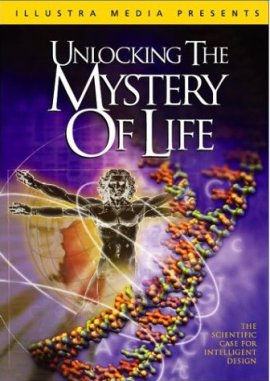
Video Review
(written by Dr Barbara Verrall, whose doctoral studies were in biochemistry)

Unlocking the Mystery of Life
Illustra Media, 2002. (65 minutes)
This video takes a look at recent ideas concerning the origin of life and promotes the theory of intelligent design.
These ideas are introduced and discussed by a number of scientists and philosophers who are, or have been, engaged in this area of research. The debates are placed in their historical context. This allows an understanding of how an increased knowledge of the structure of cells and how they work, has made these later ideas attractive.
Darwin’s voyage to the Galapagos Islands in 1831 is described, and his theory of natural selection is explained using the example of the finches he observed there. This leads on to how the action of undirected natural forces remove the need for any design, and therefore for any designer to be involved in the origin of living things.
The commentator describes a meeting of scientists and philosophers, held in 1993, to discuss evolution and its alternatives. Natural selection is seen as an adequate explanation for small alterations within a species, but not for the existence of whole complex organisms.
The complexity of organisms, and the cells they comprise was unknown to Darwin. The reasons why Darwin’s explanations are not considered sufficient to account for this degree of complexity are described using the example of the bacterial flagellum. The structure and function of this rapidly rotating whip-like structure, used by bacteria as a motor for propulsion, is described using clear animated graphics.
Darwin suggested that complex biological structures must be able to be built gradually, each small change conferring some further functional advantage that could be acted on, and conserved, by natural selection. This is compared with the lack of advantage given by a partially constructed bacterial flagellum, which would tend to be de-selected during the natural selection process. Thus the notion of irreducible complexity is introduced.
Problems with evolutionary theorists’ attempts to explain how this process may have occurred are also discussed: such as the inadequacy of the proposal that the components of the flagellum were already available because of their use in other cellular structures (co-option), and the need for the co-existence of specific assembly instructions. Darwin’s own words are quoted to highlight the seriousness of the challenge these issues pose to his theory.
The first section of the presentation is concerned with organisms and the complex structures within cells. The second section concentrates on the chemistry (the protein and DNA molecules) of cells in relation to the origin of life from non-living matter, a subject area about which Darwin had very little knowledge. However, later scientists such as Alexander Oparin suggested that life could have arisen from simple chemicals.
This suggestion is challenged, beginning with explanations of how a protein’s function relates to its structure, and how proteins are used to form the flagellar motor. The structure and function of any given protein is programmed partly by the order of the amino acids (the molecular building blocks of proteins) each amino acid having its own particular properties. One of the scientists featured in the video then speaks about work he had done suggesting that this programming system could account for the origins of the first functional proteins.
However, he himself later doubted this idea, as it was realised that DNA was required to encode the order of amino acids. So the need is now to understand the source of the biological information held in DNA. The point is also made that natural selection cannot operate before the DNA is present within cells.
The final section of the video presents arguments for intelligent design is as credible option for explaining biological origins.
Details are given of how the DNA code is read to produce messenger RNA and then how the code, now held by the RNA, is read to produce a protein (the processes of transcription and translation respectively). That amino acid order and property are not the only requirement to produce a functional protein, is shown by describing how another cellular component is required to fold the newly joined amino acids into the working form of the protein.
The point is made that intelligent design has been ruled out as an option before the evidence is considered. Design is not allowed as an explanation of science; however this is not the case in other disciplines. Work has been done to identify the logical criteria for recognition of design. Familiar illustrations are given of the proposal that design may be inferred if an improbable object or event is associated with a recognisable pattern. Following the same model, there is inference of design in the information contained in DNA, due to there being a small probability associated with the existence of the specific complex pattern of interlinking systems contained in organisms. It is suggested that in science three fundamental entities should be considered: matter, energy and information.
Although it is acknowledged that intelligent design requires a designer, no specific identification is attempted.
This video gains credibility from the input of experts engaged in the areas of study described. The familiar illustrations and good graphics make concepts easy to understand by those with a non-scientific background.
Cellular processes are far more complex than could possibly be covered in a presentation of this type. There have also been other theories put forward regarding molecular origins. However the arguments offered could be extended into other areas, and therefore hold true generally.
As a basic introduction to the challenges to evolutionary theory, and the solutions offered by intelligent design, this is a very helpful resource.
This review first appeared in Origins 44 (2006).

